Abstract
Traditionally, the cancer risks associated with radon,environmental tobacco smoke (ETS), and similar indoor residential exposures have been evaluated through either laboratory experiments in rodents or epidemiology studies in people. Laboratory studies have the advantage of being controlled experiments, but their utility as estimators of human risk is limited by the uncertainties of extrapolating from rodents to people and from high doses to those typically experienced in the home. These experiments also subject animals to noxious exposures, causing suffering that may be considered cruel. Traditional epidemiology studies evaluate human risk directly, at the exposure levels present in residences; however, these studies are limited by their potential for misclassification, biased recall, and uncontrolled confounding. The long time intervals involved between exposure and disease (often 30 years or more) make accurate recall particularly problematic. In this paper we discuss the limitations of these traditional approaches, especially as they relate to residential studies of radon and ETS. The problems associated with the maximum tolerated dose in rodent bioassays and exposure misclassification in traditional epidemiology are particularly examined. A third approach that supplements the traditional approaches and overcomes some of their limitations is suggested. This approach, dubbed pet epidemiology, estimates residential cancer risk by examining the exposure experience of pet dogs with naturally occurring cancers. The history of pet epidemiology is reviewed and its strengths and limitations are examined.
Full text
PDF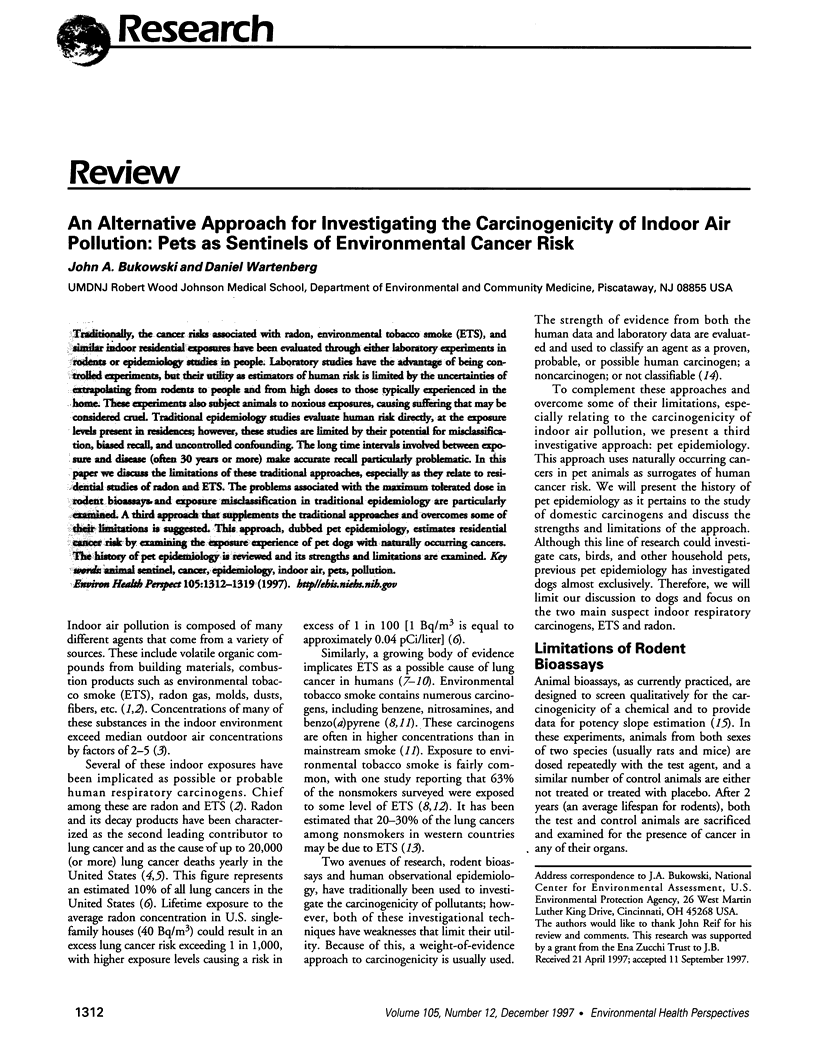

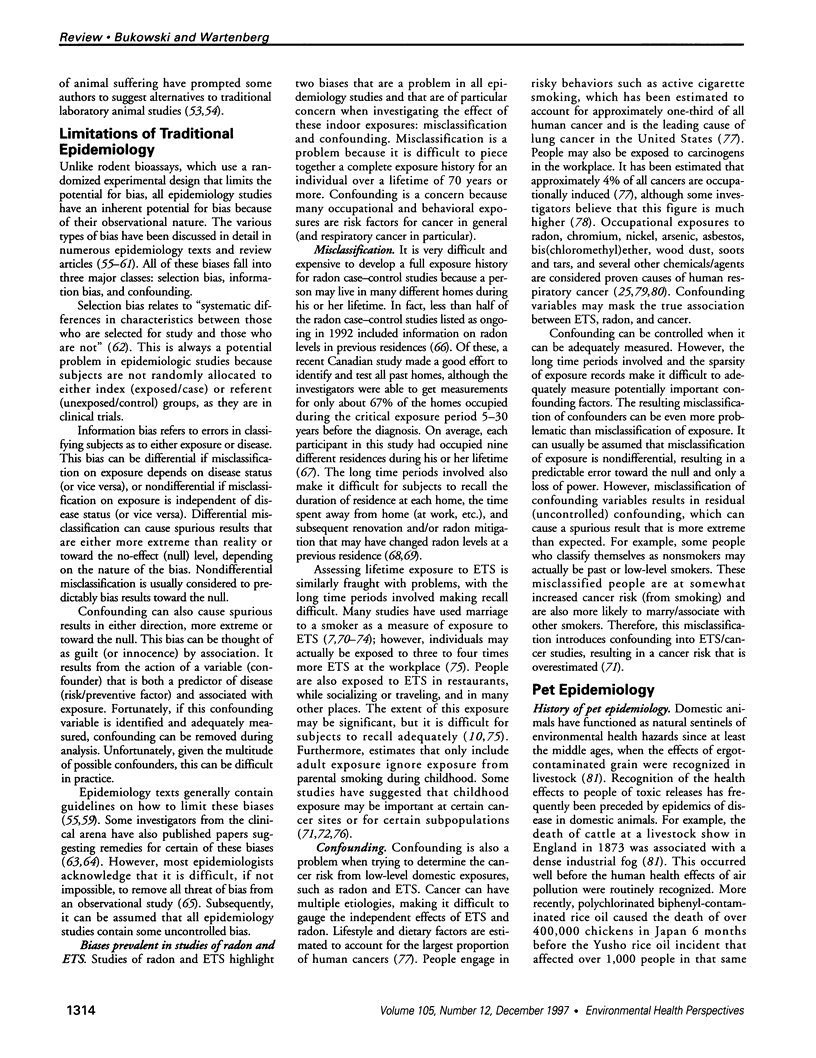
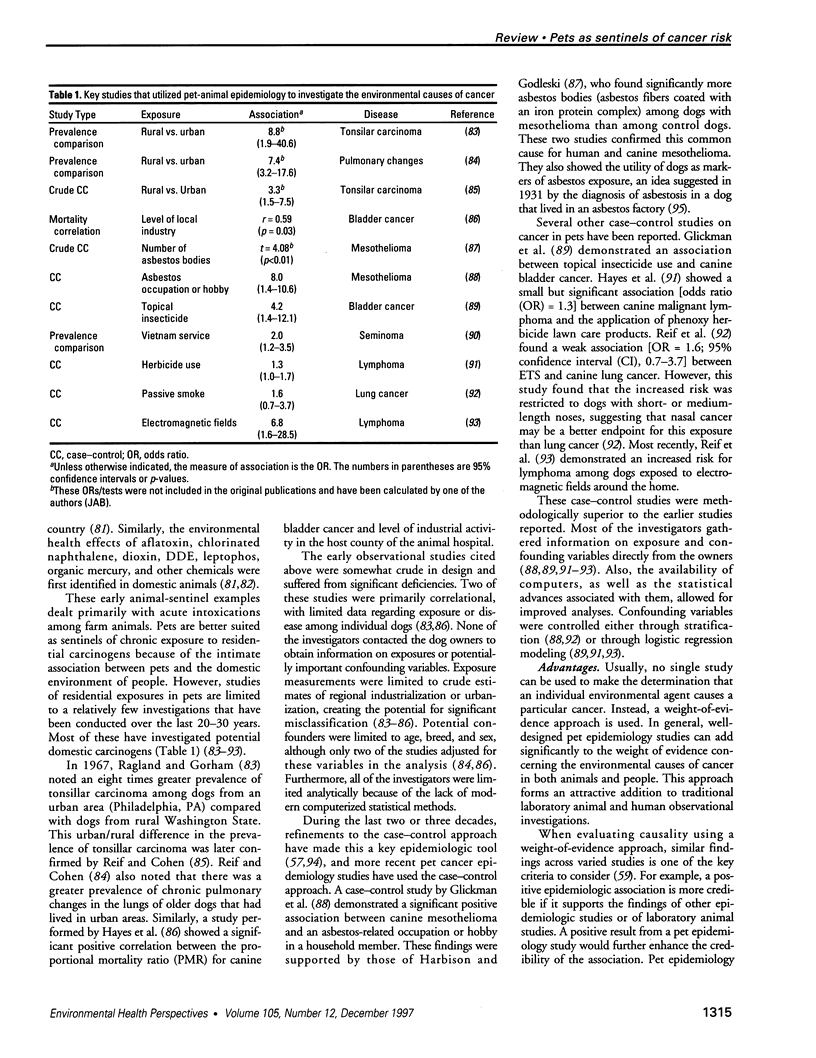
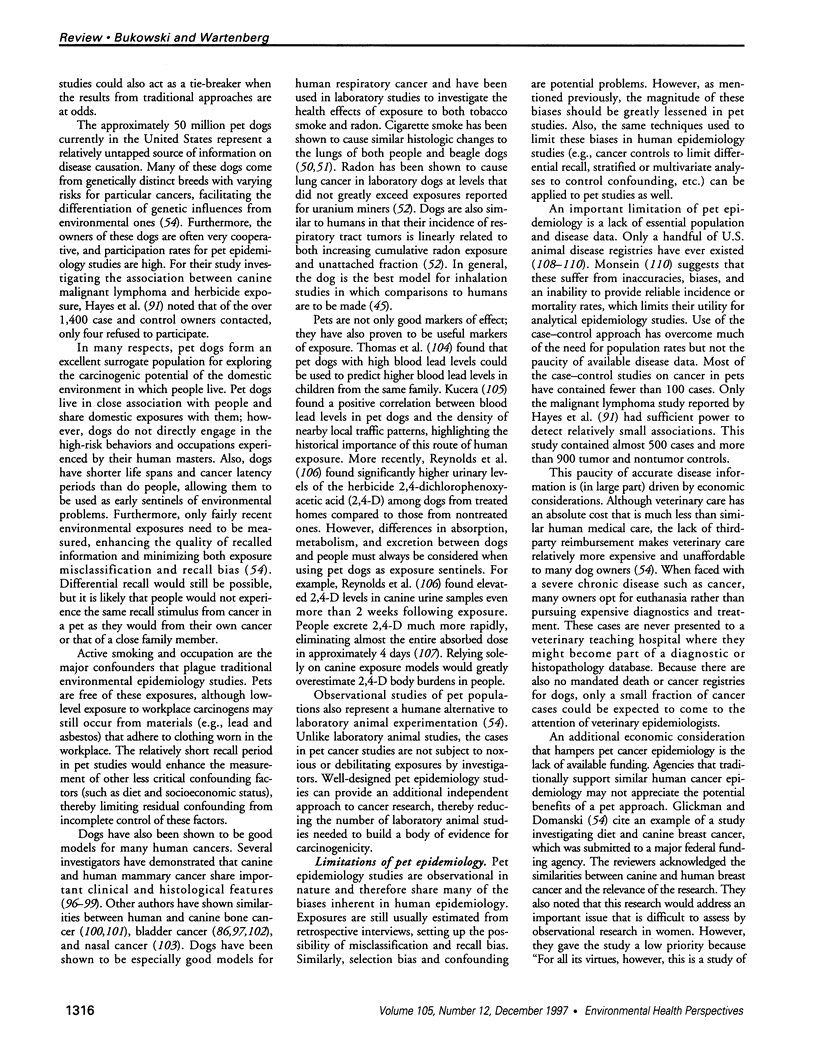
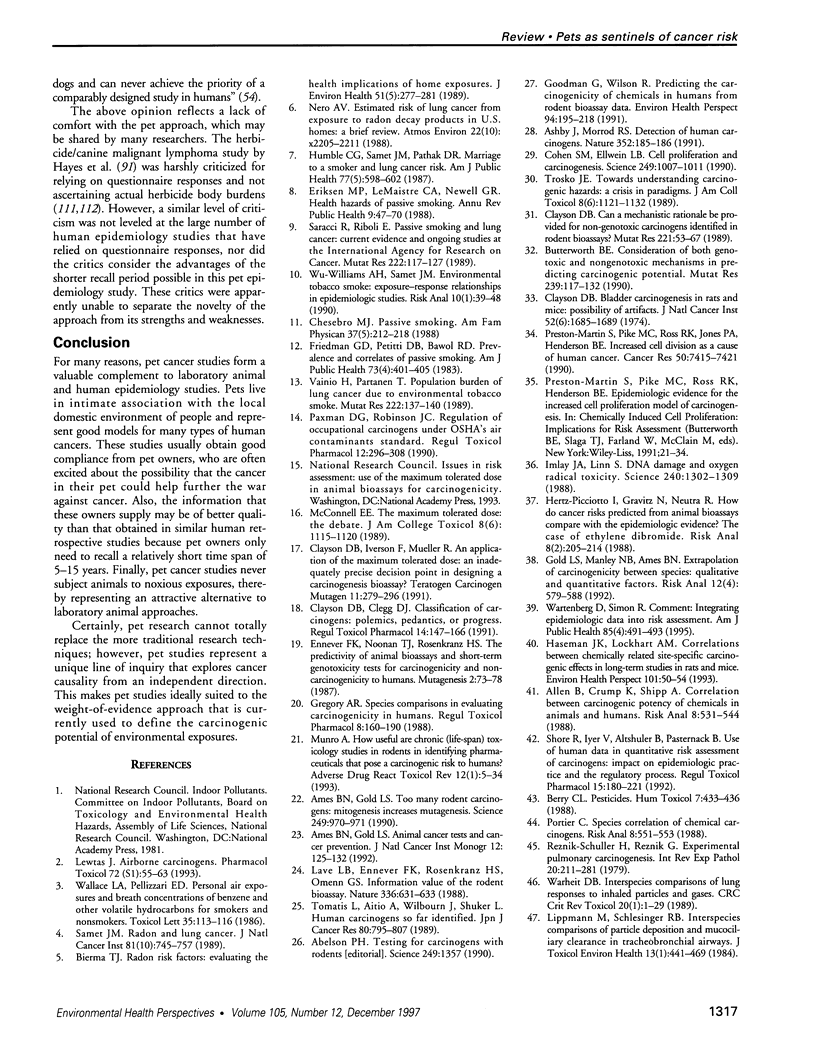
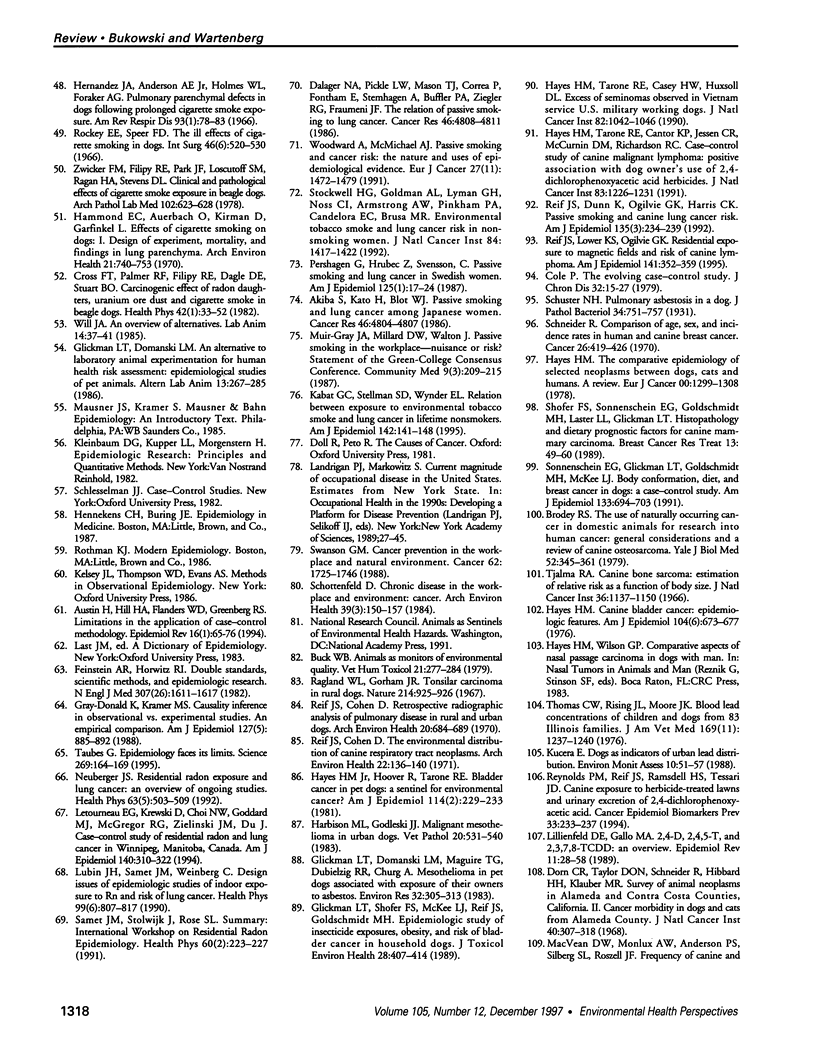
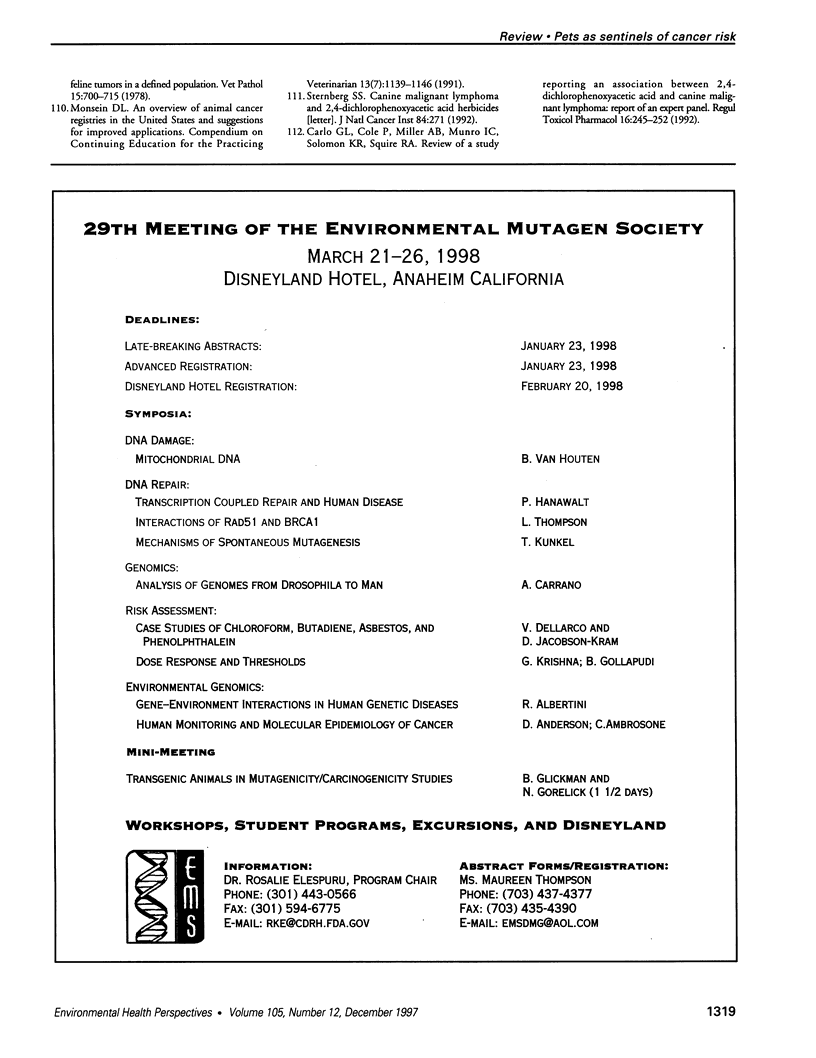
Images in this article
Selected References
These references are in PubMed. This may not be the complete list of references from this article.
- Abelson P. H. Testing for carcinogens with rodents. Science. 1990 Sep 21;249(4975):1357–1357. doi: 10.1126/science.2402628. [DOI] [PubMed] [Google Scholar]
- Akiba S., Kato H., Blot W. J. Passive smoking and lung cancer among Japanese women. Cancer Res. 1986 Sep;46(9):4804–4807. [PubMed] [Google Scholar]
- Allen B. C., Crump K. S., Shipp A. M. Correlation between carcinogenic potency of chemicals in animals and humans. Risk Anal. 1988 Dec;8(4):531–544. doi: 10.1111/j.1539-6924.1988.tb01193.x. [DOI] [PubMed] [Google Scholar]
- Ames B. N., Gold L. S. Animal cancer tests and cancer prevention. J Natl Cancer Inst Monogr. 1992;(12):125–132. [PubMed] [Google Scholar]
- Ames B. N., Gold L. S. Too many rodent carcinogens: mitogenesis increases mutagenesis. Science. 1990 Aug 31;249(4972):970–971. doi: 10.1126/science.2136249. [DOI] [PubMed] [Google Scholar]
- Ashby J., Morrod R. S. Detection of human carcinogens. Nature. 1991 Jul 18;352(6332):185–186. doi: 10.1038/352185a0. [DOI] [PubMed] [Google Scholar]
- Austin H., Hill H. A., Flanders W. D., Greenberg R. S. Limitations in the application of case-control methodology. Epidemiol Rev. 1994;16(1):65–76. doi: 10.1093/oxfordjournals.epirev.a036146. [DOI] [PubMed] [Google Scholar]
- Berry C. L. Pesticides. Hum Toxicol. 1988 Sep;7(5):433–436. doi: 10.1177/096032718800700509. [DOI] [PubMed] [Google Scholar]
- Brodey R. S. The use of naturally occurring cancer in domestic animals for research into human cancer: general considerations and a review of canine skeletal osteosarcoma. Yale J Biol Med. 1979 Jul-Aug;52(4):345–361. [PMC free article] [PubMed] [Google Scholar]
- Buck W. B. Animals as monitors of environmental quality. Vet Hum Toxicol. 1979 Aug;21(4):277–284. [PubMed] [Google Scholar]
- Butterworth B. E. Consideration of both genotoxic and nongenotoxic mechanisms in predicting carcinogenic potential. Mutat Res. 1990 Sep;239(2):117–132. doi: 10.1016/0165-1110(90)90033-8. [DOI] [PubMed] [Google Scholar]
- Carlo G. L., Cole P., Miller A. B., Munro I. C., Solomon K. R., Squire R. A. Review of a study reporting an association between 2,4-dichlorophenoxyacetic acid and canine malignant lymphoma: report of an expert panel. Regul Toxicol Pharmacol. 1992 Dec;16(3):245–252. doi: 10.1016/0273-2300(92)90004-s. [DOI] [PubMed] [Google Scholar]
- Chesebro M. J. Passive smoking. Am Fam Physician. 1988 May;37(5):212–218. [PubMed] [Google Scholar]
- Clayson D. B., Clegg D. J. Classification of carcinogens: polemics, pedantics, or progress? Regul Toxicol Pharmacol. 1991 Oct;14(2):147–166. doi: 10.1016/0273-2300(91)90003-e. [DOI] [PubMed] [Google Scholar]
- Clayson D. B. Editorial: Bladder carcinogenesis in rats and mice: possibility of artifacts. J Natl Cancer Inst. 1974 Jun;52(6):1685–1689. doi: 10.1093/jnci/52.6.1685. [DOI] [PubMed] [Google Scholar]
- Clayson D. B. International Commission for Protection Against Environmental Mutagens and Carcinogens. ICPEMC publication No. 17. Can a mechanistic rationale be provided for non-genotoxic carcinogens identified in rodent bioassays? Mutat Res. 1989 Jul;221(1):53–67. doi: 10.1016/0165-1110(89)90045-6. [DOI] [PubMed] [Google Scholar]
- Clayson D. B., Iverson F., Mueller R. An appreciation of the maximum tolerated dose: an inadequately precise decision point in designing a carcinogenesis bioassay? Teratog Carcinog Mutagen. 1991;11(6):279–296. doi: 10.1002/tcm.1770110602. [DOI] [PubMed] [Google Scholar]
- Cohen S. M., Ellwein L. B. Cell proliferation in carcinogenesis. Science. 1990 Aug 31;249(4972):1007–1011. doi: 10.1126/science.2204108. [DOI] [PubMed] [Google Scholar]
- Cole P. The evolving case-control study. J Chronic Dis. 1979;32(1-2):15–27. doi: 10.1016/0021-9681(79)90006-7. [DOI] [PubMed] [Google Scholar]
- Cross F. T., Palmer R. F., Filipy R. E., Dagle G. E., Stuart B. O. Carcinogenic effects of radon daughters, uranium ore dust and cigarette smoke in beagle dogs. Health Phys. 1982 Jan;42(1):33–52. doi: 10.1097/00004032-198201000-00004. [DOI] [PubMed] [Google Scholar]
- Dalager N. A., Pickle L. W., Mason T. J., Correa P., Fontham E., Stemhagen A., Buffler P. A., Ziegler R. G., Fraumeni J. F., Jr The relation of passive smoking to lung cancer. Cancer Res. 1986 Sep;46(9):4808–4811. [PubMed] [Google Scholar]
- Dorn C. R., Taylor D. O., Schneider R., Hibbard H. H., Klauber M. R. Survey of animal neoplasms in Alameda and Contra Costa Counties, California. II. Cancer morbidity in dogs and cats from Alameda County. J Natl Cancer Inst. 1968 Feb;40(2):307–318. [PubMed] [Google Scholar]
- Ennever F. K., Noonan T. J., Rosenkranz H. S. The predictivity of animal bioassays and short-term genotoxicity tests for carcinogenicity and non-carcinogenicity to humans. Mutagenesis. 1987 Mar;2(2):73–78. doi: 10.1093/mutage/2.2.73. [DOI] [PubMed] [Google Scholar]
- Eriksen M. P., LeMaistre C. A., Newell G. R. Health hazards of passive smoking. Annu Rev Public Health. 1988;9:47–70. doi: 10.1146/annurev.pu.09.050188.000403. [DOI] [PubMed] [Google Scholar]
- Feinstein A. R., Horwitz R. I. Double standards, scientific methods, and epidemiologic research. N Engl J Med. 1982 Dec 23;307(26):1611–1617. doi: 10.1056/NEJM198212233072604. [DOI] [PubMed] [Google Scholar]
- Friedman G. D., Petitti D. B., Bawol R. D. Prevalence and correlates of passive smoking. Am J Public Health. 1983 Apr;73(4):401–405. doi: 10.2105/ajph.73.4.401. [DOI] [PMC free article] [PubMed] [Google Scholar]
- Glickman L. T., Domanski L. M., Maguire T. G., Dubielzig R. R., Churg A. Mesothelioma in pet dogs associated with exposure of their owners to asbestos. Environ Res. 1983 Dec;32(2):305–313. doi: 10.1016/0013-9351(83)90114-7. [DOI] [PubMed] [Google Scholar]
- Glickman L. T., Schofer F. S., McKee L. J., Reif J. S., Goldschmidt M. H. Epidemiologic study of insecticide exposures, obesity, and risk of bladder cancer in household dogs. J Toxicol Environ Health. 1989;28(4):407–414. doi: 10.1080/15287398909531360. [DOI] [PubMed] [Google Scholar]
- Gold L. S., Manley N. B., Ames B. N. Extrapolation of carcinogenicity between species: qualitative and quantitative factors. Risk Anal. 1992 Dec;12(4):579–588. doi: 10.1111/j.1539-6924.1992.tb00714.x. [DOI] [PubMed] [Google Scholar]
- Goodman G., Wilson R. Predicting the carcinogenicity of chemicals in humans from rodent bioassay data. Environ Health Perspect. 1991 Aug;94:195–218. doi: 10.1289/ehp.94-1567942. [DOI] [PMC free article] [PubMed] [Google Scholar]
- Gray-Donald K., Kramer M. S. Causality inference in observational vs. experimental studies. An empirical comparison. Am J Epidemiol. 1988 May;127(5):885–892. doi: 10.1093/oxfordjournals.aje.a114891. [DOI] [PubMed] [Google Scholar]
- Gregory A. R. Species comparisons in evaluating carcinogenicity in humans. Regul Toxicol Pharmacol. 1988 Jun;8(2):160–190. doi: 10.1016/0273-2300(88)90027-x. [DOI] [PubMed] [Google Scholar]
- Hammond E. C., Auerbach O., Kirman D., Garfinkel L. Effects of cigarette smoking on dogs. Arch Environ Health. 1970 Dec;21(6):740–753. doi: 10.1080/00039896.1970.10667328. [DOI] [PubMed] [Google Scholar]
- Harbison M. L., Godleski J. J. Malignant mesothelioma in urban dogs. Vet Pathol. 1983 Sep;20(5):531–540. doi: 10.1177/030098588302000504. [DOI] [PubMed] [Google Scholar]
- Haseman J. K., Lockhart A. M. Correlations between chemically related site-specific carcinogenic effects in long-term studies in rats and mice. Environ Health Perspect. 1993 Apr 22;101(1):50–54. doi: 10.1289/ehp.9310150. [DOI] [PMC free article] [PubMed] [Google Scholar]
- Hayes H. H., Jr The comparative epidemiology of selected neoplasms between dogs, cats and humans. A review. Eur J Cancer. 1978 Dec;14(12):1299–1308. doi: 10.1016/0014-2964(78)90111-1. [DOI] [PubMed] [Google Scholar]
- Hayes H. M., Jr Canine bladder cancer: epidemiologic features. Am J Epidemiol. 1976 Dec;104(6):673–677. doi: 10.1093/oxfordjournals.aje.a112346. [DOI] [PubMed] [Google Scholar]
- Hayes H. M., Jr, Hoover R., Tarone R. E. Bladder cancer in pet dogs: a sentinel for environmental cancer? Am J Epidemiol. 1981 Aug;114(2):229–233. doi: 10.1093/oxfordjournals.aje.a113186. [DOI] [PubMed] [Google Scholar]
- Hayes H. M., Tarone R. E., Cantor K. P., Jessen C. R., McCurnin D. M., Richardson R. C. Case-control study of canine malignant lymphoma: positive association with dog owner's use of 2,4-dichlorophenoxyacetic acid herbicides. J Natl Cancer Inst. 1991 Sep 4;83(17):1226–1231. doi: 10.1093/jnci/83.17.1226. [DOI] [PubMed] [Google Scholar]
- Hayes H. M., Tarone R. E., Casey H. W., Huxsoll D. L. Excess of seminomas observed in Vietnam service U.S. military working dogs. J Natl Cancer Inst. 1990 Jun 20;82(12):1042–1046. doi: 10.1093/jnci/82.12.1042. [DOI] [PubMed] [Google Scholar]
- Hernandez J. A., Anderson A. E., Jr, Holmes W. L., Foraker A. G. Pulmonary parenchymal defects in dogs following prolonged cigarette smoke exposure. Am Rev Respir Dis. 1966 Jan;93(1):78–83. doi: 10.1164/arrd.1966.93.1.78. [DOI] [PubMed] [Google Scholar]
- Hertz-Picciotto I., Gravitz N., Neutra R. How do cancer risks predicted from animal bioassays compare with the epidemiologic evidence? The case of ethylene dibromide. Risk Anal. 1988 Jun;8(2):205–214. doi: 10.1111/j.1539-6924.1988.tb01173.x. [DOI] [PubMed] [Google Scholar]
- Humble C. G., Samet J. M., Pathak D. R. Marriage to a smoker and lung cancer risk. Am J Public Health. 1987 May;77(5):598–602. doi: 10.2105/ajph.77.5.598. [DOI] [PMC free article] [PubMed] [Google Scholar]
- Imlay J. A., Linn S. DNA damage and oxygen radical toxicity. Science. 1988 Jun 3;240(4857):1302–1309. doi: 10.1126/science.3287616. [DOI] [PubMed] [Google Scholar]
- Kabat G. C., Stellman S. D., Wynder E. L. Relation between exposure to environmental tobacco smoke and lung cancer in lifetime nonsmokers. Am J Epidemiol. 1995 Jul 15;142(2):141–148. doi: 10.1093/oxfordjournals.aje.a117612. [DOI] [PubMed] [Google Scholar]
- Lave L. B., Ennever F. K., Rosenkranz H. S., Omenn G. S. Information value of the rodent bioassay. Nature. 1988 Dec 15;336(6200):631–633. doi: 10.1038/336631a0. [DOI] [PubMed] [Google Scholar]
- Lewtas J. Airborne carcinogens. Pharmacol Toxicol. 1993;72 (Suppl 1):55–63. doi: 10.1111/j.1600-0773.1993.tb01670.x. [DOI] [PubMed] [Google Scholar]
- Lilienfeld D. E., Gallo M. A. 2,4-D, 2,4,5-T, and 2,3,7,8-TCDD: an overview. Epidemiol Rev. 1989;11:28–58. doi: 10.1093/oxfordjournals.epirev.a036044. [DOI] [PubMed] [Google Scholar]
- Lippmann M., Schlesinger R. B. Interspecies comparisons of particle deposition and mucociliary clearance in tracheobronchial airways. J Toxicol Environ Health. 1984;13(2-3):441–469. doi: 10.1080/15287398409530509. [DOI] [PubMed] [Google Scholar]
- Lubin J. H., Samet J. M., Weinberg C. Design issues in epidemiologic studies of indoor exposure to Rn and risk of lung cancer. Health Phys. 1990 Dec;59(6):807–817. doi: 10.1097/00004032-199012000-00004. [DOI] [PubMed] [Google Scholar]
- Létourneau E. G., Krewski D., Choi N. W., Goddard M. J., McGregor R. G., Zielinski J. M., Du J. Case-control study of residential radon and lung cancer in Winnipeg, Manitoba, Canada. Am J Epidemiol. 1994 Aug 15;140(4):310–322. doi: 10.1093/oxfordjournals.aje.a117253. [DOI] [PubMed] [Google Scholar]
- MacVean D. W., Monlux A. W., Anderson P. S., Jr, Silberg S. L., Roszel J. F. Frequency of canine and feline tumors in a defined population. Vet Pathol. 1978 Nov;15(6):700–715. doi: 10.1177/030098587801500602. [DOI] [PubMed] [Google Scholar]
- Monro A. How useful are chronic (life-span) toxicology studies in rodents in identifying pharmaceuticals that pose a carcinogenic risk to humans? Adverse Drug React Toxicol Rev. 1993 Spring;12(1):5–34. [PubMed] [Google Scholar]
- Neuberger J. S. Residential radon exposure and lung cancer: an overview of ongoing studies. Health Phys. 1992 Nov;63(5):503–509. doi: 10.1097/00004032-199211000-00001. [DOI] [PubMed] [Google Scholar]
- Paxman D. G., Robinson J. C. Regulation of occupational carcinogens under OSHA's Air Contaminants Standard. Regul Toxicol Pharmacol. 1990 Dec;12(3 Pt 1):296–308. doi: 10.1016/s0273-2300(05)80065-0. [DOI] [PubMed] [Google Scholar]
- Pershagen G., Hrubec Z., Svensson C. Passive smoking and lung cancer in Swedish women. Am J Epidemiol. 1987 Jan;125(1):17–24. doi: 10.1093/oxfordjournals.aje.a114504. [DOI] [PubMed] [Google Scholar]
- Portier C. J. Species correlation of chemical carcinogens. Risk Anal. 1988 Dec;8(4):551–553. doi: 10.1111/j.1539-6924.1988.tb01196.x. [DOI] [PubMed] [Google Scholar]
- Preston-Martin S., Pike M. C., Ross R. K., Jones P. A., Henderson B. E. Increased cell division as a cause of human cancer. Cancer Res. 1990 Dec 1;50(23):7415–7421. [PubMed] [Google Scholar]
- Ragland W. L., 3rd, Gorham J. R. Tonsillar carcinoma in rural dogs. Nature. 1967 May 27;214(5091):925–926. doi: 10.1038/214925a0. [DOI] [PubMed] [Google Scholar]
- Reif J. S., Cohen D. Canine pulmonary disease. II. Retrospective radiographic analysis of pulmonary disease in rural and urban dogs. Arch Environ Health. 1970 Jun;20(6):684–689. doi: 10.1080/00039896.1970.10665644. [DOI] [PubMed] [Google Scholar]
- Reif J. S., Cohen D. The environmental distribution of canine respiratory tract neoplasms. Arch Environ Health. 1971 Jan;22(1):136–140. doi: 10.1080/00039896.1971.10665823. [DOI] [PubMed] [Google Scholar]
- Reif J. S., Dunn K., Ogilvie G. K., Harris C. K. Passive smoking and canine lung cancer risk. Am J Epidemiol. 1992 Feb 1;135(3):234–239. doi: 10.1093/oxfordjournals.aje.a116276. [DOI] [PubMed] [Google Scholar]
- Reif J. S., Lower K. S., Ogilvie G. K. Residential exposure to magnetic fields and risk of canine lymphoma. Am J Epidemiol. 1995 Feb 15;141(4):352–359. doi: 10.1093/aje/141.4.352. [DOI] [PubMed] [Google Scholar]
- Reynolds P. M., Reif J. S., Ramsdell H. S., Tessari J. D. Canine exposure to herbicide-treated lawns and urinary excretion of 2,4-dichlorophenoxyacetic acid. Cancer Epidemiol Biomarkers Prev. 1994 Apr-May;3(3):233–237. [PubMed] [Google Scholar]
- Reznik-Schüller H., Reznik G. Experimental pulmonary carcinogenesis. Int Rev Exp Pathol. 1979;20:211–281. [PubMed] [Google Scholar]
- Rockey E. E., Speer F. D. The ill effects of cigarette smoking in dogs. Int Surg. 1966 Dec;46(6):520–530. [PubMed] [Google Scholar]
- Samet J. M. Radon and lung cancer. J Natl Cancer Inst. 1989 May 10;81(10):745–757. doi: 10.1093/jnci/81.10.745. [DOI] [PubMed] [Google Scholar]
- Samet J. M., Stolwijk J., Rose S. L. Summary: International workshop on residential Rn epidemiology. Health Phys. 1991 Feb;60(2):223–227. doi: 10.1097/00004032-199102000-00010. [DOI] [PubMed] [Google Scholar]
- Saracci R., Riboli E. Passive smoking and lung cancer: current evidence and ongoing studies at the International Agency for Research on Cancer. Mutat Res. 1989 Feb;222(2):117–127. doi: 10.1016/0165-1218(89)90025-6. [DOI] [PubMed] [Google Scholar]
- Schneider R. Comparison of age, sex, and incidence rates in human and canine breast cancer. Cancer. 1970 Aug;26(2):419–426. doi: 10.1002/1097-0142(197008)26:2<419::aid-cncr2820260225>3.0.co;2-u. [DOI] [PubMed] [Google Scholar]
- Schottenfeld D. Chronic disease in the workplace and environment: cancer. Arch Environ Health. 1984 May-Jun;39(3):150–157. doi: 10.1080/00039896.1984.9939516. [DOI] [PubMed] [Google Scholar]
- Shofer F. S., Sonnenschein E. G., Goldschmidt M. H., Laster L. L., Glickman L. T. Histopathologic and dietary prognostic factors for canine mammary carcinoma. Breast Cancer Res Treat. 1989 Jan;13(1):49–60. doi: 10.1007/BF01806550. [DOI] [PubMed] [Google Scholar]
- Shore R. E., Iyer V., Altshuler B., Pasternack B. S. Use of human data in quantitative risk assessment of carcinogens: impact on epidemiologic practice and the regulatory process. Regul Toxicol Pharmacol. 1992 Apr;15(2 Pt 1):180–221. doi: 10.1016/0273-2300(92)90049-f. [DOI] [PubMed] [Google Scholar]
- Sonnenschein E. G., Glickman L. T., Goldschmidt M. H., McKee L. J. Body conformation, diet, and risk of breast cancer in pet dogs: a case-control study. Am J Epidemiol. 1991 Apr 1;133(7):694–703. doi: 10.1093/oxfordjournals.aje.a115944. [DOI] [PubMed] [Google Scholar]
- Sternberg S. S. Canine malignant lymphoma and 2,4-dichlorophenoxyacetic acid herbicides. J Natl Cancer Inst. 1992 Feb 19;84(4):271–271. doi: 10.1093/jnci/84.4.271. [DOI] [PubMed] [Google Scholar]
- Stockwell H. G., Goldman A. L., Lyman G. H., Noss C. I., Armstrong A. W., Pinkham P. A., Candelora E. C., Brusa M. R. Environmental tobacco smoke and lung cancer risk in nonsmoking women. J Natl Cancer Inst. 1992 Sep 16;84(18):1417–1422. doi: 10.1093/jnci/84.18.1417. [DOI] [PubMed] [Google Scholar]
- Swanson G. M. Cancer prevention in the workplace and natural environment. A review of etiology, research design, and methods of risk reduction. Cancer. 1988 Oct 15;62(8 Suppl):1725–1746. doi: 10.1002/1097-0142(19881015)62:1+<1725::aid-cncr2820621310>3.0.co;2-e. [DOI] [PubMed] [Google Scholar]
- Taubes G. Epidemiology faces its limits. Science. 1995 Jul 14;269(5221):164–169. doi: 10.1126/science.7618077. [DOI] [PubMed] [Google Scholar]
- Thomas C. W., Rising J. L., Moore J. K. Blood lead concentrations of children and dogs from 83 Illinois families. J Am Vet Med Assoc. 1976 Dec 1;169(11):1237–1240. [PubMed] [Google Scholar]
- Tjalma R. A. Canine bone sarcoma: estimation of relative risk as a function of body size. J Natl Cancer Inst. 1966 Jun;36(6):1137–1150. [PubMed] [Google Scholar]
- Tomatis L., Aitio A., Wilbourn J., Shuker L. Human carcinogens so far identified. Jpn J Cancer Res. 1989 Sep;80(9):795–807. doi: 10.1111/j.1349-7006.1989.tb01717.x. [DOI] [PMC free article] [PubMed] [Google Scholar]
- Vainio H., Partanen T. Population burden of lung cancer due to environmental tobacco smoke. Mutat Res. 1989 Feb;222(2):137–140. doi: 10.1016/0165-1218(89)90027-x. [DOI] [PubMed] [Google Scholar]
- Wallace L. A., Pellizzari E. D. Personal air exposures and breath concentrations of benzene and other volatile hydrocarbons for smokers and nonsmokers. Toxicol Lett. 1987 Jan;35(1):113–116. doi: 10.1016/0378-4274(87)90094-4. [DOI] [PubMed] [Google Scholar]
- Warheit D. B. Interspecies comparisons of lung responses to inhaled particles and gases. Crit Rev Toxicol. 1989;20(1):1–29. doi: 10.3109/10408448909037474. [DOI] [PubMed] [Google Scholar]
- Wartenberg D., Simon R. Comment: integrating epidemiologic data into risk assessment. Am J Public Health. 1995 Apr;85(4):491–493. doi: 10.2105/ajph.85.4.491. [DOI] [PMC free article] [PubMed] [Google Scholar]
- Woodward A., McMichael A. J. Passive smoking and cancer risk: the nature and uses of epidemiological evidence. Eur J Cancer. 1991;27(11):1472–1479. doi: 10.1016/0277-5379(91)90034-b. [DOI] [PubMed] [Google Scholar]
- Wu-Williams A. H., Samet J. M. Environmental tobacco smoke: exposure-response relationships in epidemiologic studies. Risk Anal. 1990 Mar;10(1):39–48. doi: 10.1111/j.1539-6924.1990.tb01018.x. [DOI] [PubMed] [Google Scholar]
- Zwicker G. M., Filipy R. E., Park J. F., Loscutoff S. M., Ragan H. A., Stevens D. L. Clinical and pathological effects of cigarette smoke exposure in beagle dogs. Arch Pathol Lab Med. 1978 Dec;102(12):623–628. [PubMed] [Google Scholar]



